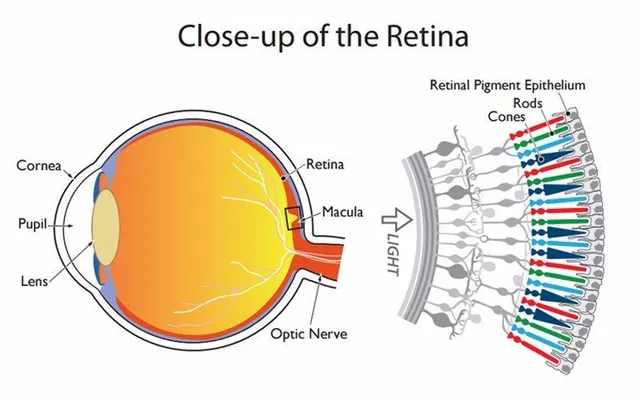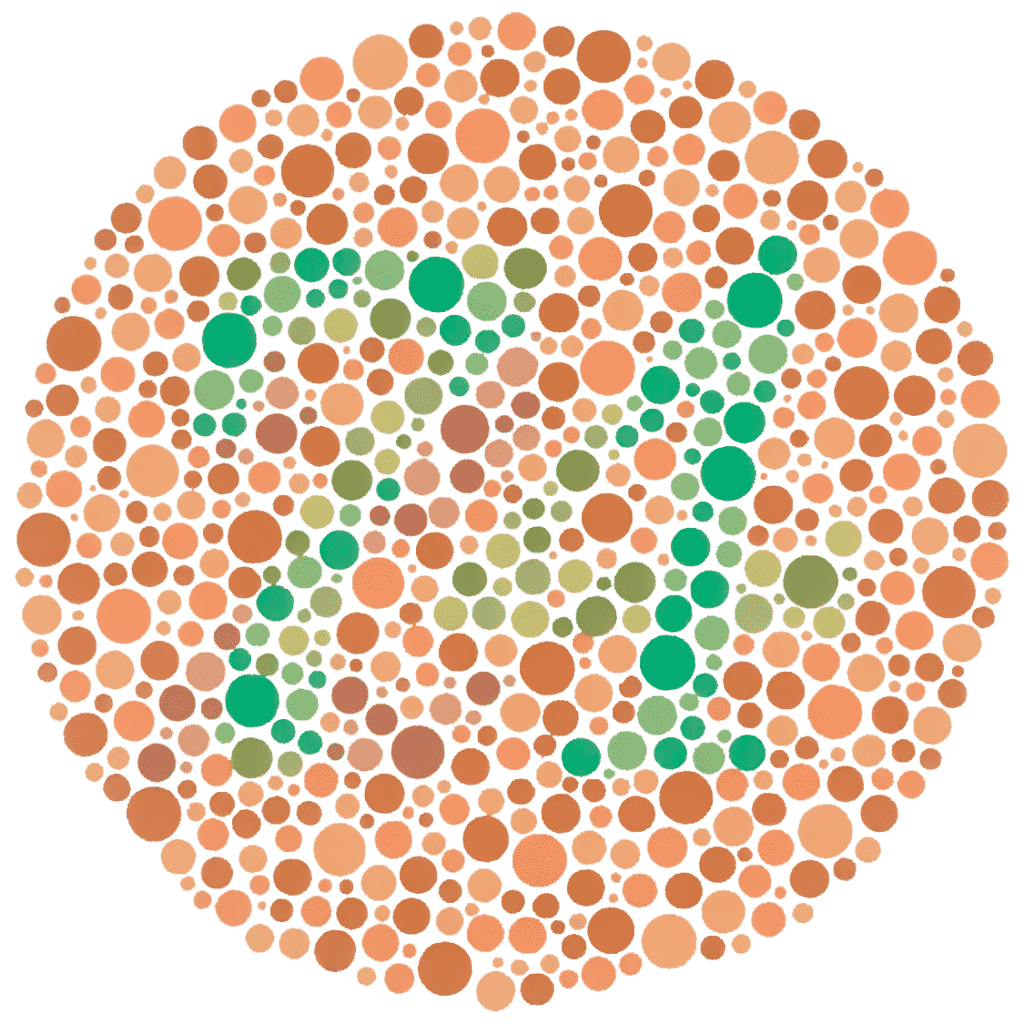Colour blindness is a condition which occurs when people are unable to see colours normally or not at all. There are many forms of colour blindness, the two most common being red-green colour blindness and blue-yellow colour blindness. A person with normal colour vision could probably see about 1-10 million distinct colours, whereas a colour-blind person may only see about 10%.
People with colour blindness will experience trouble seeing specific or all colours and the brightness and saturation of colours. They will be unable to detect the difference between the same or similar shades, depending on the type of colour blindness they may have.
A person with red-green colour blindness will experience troubles differentiating between hues of red and green, the same goes for blue-yellow colour blindness with the colours blue and yellow.
Red-green colour blindness is located on the X sex chromosome through a mutation on the OPN1MW or the OPN1LW gene and blue-yellow colour blindness is autosomal and located as a mutation on chromosome 7 on the OPN1SW gene. This mutation may cause the development of cone cells in the eye to become faulty. Light-sensitive cells in the retina can also fail to respond to wavelengths of light, which is another cause of colour blindness.

Red-green colour blindness is caused when the ‘L’ cones, responsible for seeing red, and the ‘M’ cones, mainly responsible for seeing green, are damaged or faulty. The ‘M’ cone cells are not necessarily absent in the eye, they just do not detect as much green as normal and are more sensitive to colours such as oranges, yellows, and reds or vice versa. Therefore, they would usually appear similar in colour.
Blue-yellow colour blindness is caused when the ‘S’ cone cells are damaged or faulty and have little or no blue sensitivity. This can cause blue colours to appear green and the colour yellow to appear purple or red.
Red-green colour blindness is a sex-linked disorder, located on the X chromosome and is also a recessive trait. This means that if a mother has red-green colour blindness, then the father must also have colour blindness for their daughter to have it. Only the mother must have the colour blindness for their son to have it because the mother gives an X chromosome and the father gives a Y. Therefore, reinforcing the fact that red-green colour blindness is more common in males than in females.
Blue-yellow colour blindness, however, is a dominant trait but is not sex-linked. This means that it requires only one copy of the gene to have the disorder. Either the mother or the father must have colour blindness for the daughter to have it and the mother must have it for the son to have blue-yellow colour blindness.
Below are two different punnet squares, illustrating the probability of a child with the colour blindness disorder when a mother is a carrier or heterozygous and the father has no form of the disorder. Red-green colour blindness shows there is a 1 in 4 chance for a child to be born with the disorder, that child being male. Blue-yellow colour blindness shows that there is a 3 in 4 chance that the child will get the disorder. As large as that chance is out of the couple, blue-yellow colour blindness is still very rare as 1 in 10,000 people have it.
Mother-carrier/heterozygous & Father-none/homozygous

As of now, there is no known cure for colour blindness, however, there are certain treatments that may help. There are filtered colour lenses and glasses that can help colour deficiencies. These glasses are filtered to enhance the brightness between colours, making them more easily distinguishable. This may seem like a good choice, however, many people with colour blindness have commented that these glasses and lenses make everything more confusing, rather than helping them.
Gene therapy has shown to be able to correct a monkey’s colour blindness and may work for humans. They do this by placing certain colour-recognising genes (photopigments) into the cells of the eyes which can allow the monkey to tell the difference between colours.

Colour blindness can be tested and diagnosed in a variety of different ways and tests;
- Ishihara Colour Test- a test for colour perception, mainly for red-green colour blindness. It consists of a plate of coloured dots, with a number hidden in it of a different colour (red and green)
- Cambridge Colour Test- a test commonly used to diagnose red-green colour blindness which uses dots of different colours, like the Ishihara Colour Test, however, it is a computerized test
- Anomaloscope colour blindness- a test that asks you to match two colours in different boxes
- Farnsworth-Munsell 100 hue test- patients are asked to line up blocks in order of hue
- Farnsworth lantern test- the patient is shown lights and are asked to identify the colour
Genetic counselling is available for colour-blind people and can help people suffering from colour blindness and their families by explaining the disorder to them specifically, what ways they can adapt and help with colour blindness.
Red-green colour blindness is found to be more common in males as 1 in 12 men (8%) have the disorder and 1 in 200 women (0.5%) also has it. This is since red-green colour blindness is sex-linked and recessive. This means that males would have to have one of the genotypes to have the disorder, however, females would need to have two of the genotypes as it is recessive. Red-green colour blindness is the most common form of colour blindness as more than 99% of all colour-blind people have red-green colour blindness. Blue-yellow colour-blindness is quite rare as 1 out of 10,000 people are affected (0.01%) affecting both males and females equally.
Bibliography
American Academy
of Opthalmology, 2019. What Are the Symptoms and Causes of Color
Blindness?. [Online]
Available at: https://www.aao.org/eye-health/diseases/color-blindness-symptoms
[Accessed 27 February 2020].
Bausch + Lomb, 2020. Colour Blindness. [Online]
Available at: https://www.bausch.com/your-eye-concerns/diseases-and-disorders/color-blindness
[Accessed 27 February 2020].
Colblindor, 2018. What is Color Blindness? [Online]
Available at: https://www.color-blindness.com/what-is-color-blindness/
[Accessed 27 February 2020].
Cold Spring Harbor Laboratory DNA Learning Centre, 2020. What
is colour blindness?. [Online]
Available at: https://dnalc.cshl.edu/view/15940-What-is-color-blindness-.html
[Accessed 27 February 2020].
Colour Blind Awareness, 2020. Colour Blindness. [Online]
Available at: http://www.colourblindawareness.org/colour-blindness/
[Accessed 27 February 2020].
Colour Blind Awareness, 2020. Inherited Colour Vision
Deficiency. [Online]
Available at: http://www.colourblindawareness.org/colour-blindness/inherited-colour-vision-deficiency/
[Accessed 27 February 2020].
Cooper Vision, 2015. All the Different Kinds of Color
Blindness. [Online]
Available at: https://coopervision.com/blog/all-different-kinds-color-blindness
[Accessed 3 March 2020].
Enchroma, 2020. Types of Color Blindness. [Online]
Available at: https://enchroma.com/pages/types-of-color-blindness
[Accessed 3 March 2020].
Everyday Health, 2016. Color Blindness Test and
Diagnosis. [Online]
Available at: https://www.everydayhealth.com/color-blindness/guide/test-and-diagnosis/
[Accessed 27 February 2020].
Human Genetics Society of Australasia, 2020. DEFINITION
OF GENETIC COUNSELLING. [Online]
Available at: https://www.hgsa.org.au/asgc/definition-of-genetic-counselling
[Accessed 27 February 2020].
OMIM, 2010. COLORBLINDNESS, PARTIAL, DEUTAN SERIES; CBD.
[Online]
Available at: https://www.omim.org/entry/303800
[Accessed 3 March 2020].
Wikipedia, 2019. Gene therapy for color blindness. [Online]
Available at: https://en.wikipedia.org/wiki/Gene_therapy_for_color_blindness
[Accessed 27 February 2020].
